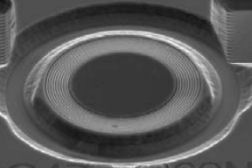Etching a series of concentric ridges around the lamp-on-a-chip known as a light-emitting diode, or LED, flings forward light that otherwise would be lost to the sides or back of the device. The ridges boost an LED’s brightness seven-fold compared with the same LED without the ridges, Mark Y. Su and Richard P. Mirin, both of the National Institute of Standards and Technology in Boulder, Colo., report in the July 17 Applied Physics Letters.

The physicists used experimental LEDs that they had designed to emit infrared radiation when illuminated by an infrared laser. Su says that he expects ridges to also improve performance of standard LEDs, which emit light in response to electric current. Interference among light waves passing through the ridges bends those waves’ paths in the right direction, Su explains.
The researchers note that ordinary LEDs send about 98 percent of their emissions in directions where the light goes to waste. In contrast, the new devices, which include a mirror beneath the LED as well as the ridges around it, project about 40 percent of their light forward, the team reports.
LEDs are increasingly replacing many conventional lamps—for instance, in flashlights, vehicle taillights, and traffic signals (SN: 5/20/06, p. 314: Illuminating Changes). However, adding ridges and mirrors to the various visible-light LEDs will require further research, Su says.
Because such modifications might make the costs of common LEDs excessive, manufacturers are more likely to apply the enhancements to high-performance LEDs, such as those used in optical telecommunications, Su says.







